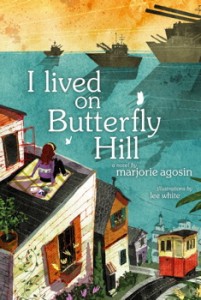 Marjorie Agosín is an acclaimed poet and essayist whose dozens of published works explore the lives of women and Jews in her native Chile and the struggle for human rights around the world. I Lived on Butterfly Hill (Simon & Schuster, 2014) is her first novel for young readers, the story of 11-year-old Celeste Marconi, who lives with her parents, grandmother, and Nana (nanny who is considered part of the family) in the port city of Valparaíso, Chile.
Marjorie Agosín is an acclaimed poet and essayist whose dozens of published works explore the lives of women and Jews in her native Chile and the struggle for human rights around the world. I Lived on Butterfly Hill (Simon & Schuster, 2014) is her first novel for young readers, the story of 11-year-old Celeste Marconi, who lives with her parents, grandmother, and Nana (nanny who is considered part of the family) in the port city of Valparaíso, Chile.
Celeste knows something is wrong when she sees the harbor full of large ships. Her friends don’t notice, except for Cristóbal Williams, whose magic pendulum also shows trouble. Celeste’s parents, both doctors, are busy helping the victims of a landslide in a poor neighborhood of her city, which is built on 42 steep hills. Shortly afterward, a military coup topples the elected government, and her parents, both supporters of the democratic government, go into hiding, leaving the youngster in the care of her grandmother, who escaped the Holocaust, and Nana Delfina. At school, things change as well. Her beloved principal flees and is replaced by a military officer. One of her best friends disappears along with her parents. Girls are forced to wear skirts, and boys must cut their hair short. Children who fall asleep in class, give the wrong answers, or misbehave are beaten. Eventually, Celeste’s parents send word that it’s time for her to leave the country.
Now 12 years old, Celeste travels alone to Maine to live with her Tía Graciela, her mother’s flighty sister. Here, she adjusts to a new language and culture, but two years later, just when she begins to feel comfortable in her new home, the dictatorship falls, and she is sent back. But her parents are still missing, and with the help of old friend Cristóbal and his magic pendulum, she sets about trying to locate her parents and all the other disappeared.
Agosín’s novel is based on a real history, though she compresses the time period—the Pinochet dictatorship in fact lasted 17 years from 1973 to 1990—and changes other details in the service of her story. As a result, her focus is on Celeste and her world of coastal Valparaíso and coastal Maine. Both settings are exquisitely drawn, and Lee White’s charming illustrations add much to this unique middle grade novel. Magic and mysticism are important elements, and Agosín adds dimension and depth by showing how children and adults from the different cultures within Chile—including Nana Delfina, a Mapuche woman from the south of Chile, and Grandmother Frida, a Jewish refugee from Central Europe—incorporate the supernatural into their lives. Celeste emerges as a strong character, one who will engage and inspire middle grade readers, as she allays the suspicions of her Maine classmates to become a good friend to them and later on, as she leads a harrowing search to find her missing father. In a market filled with narrow, formulaic, cookie-cutter books, I Lived on Butterfly Hill is a standout, a novel that will challenge middle grade readers and show them that there is a fascinating and beautiful world beyond their horizons.
Next week’s post will feature an interview with Marjorie Agosín.
1 comment for “From Chile to Maine and Back: A Review of I Lived on Butterfly Hill”